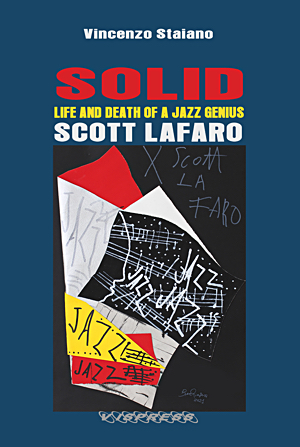Home » Jazz Articles » Book Review » Solid. Life and Death of a Jazz Genius: Scott LaFaro
Solid. Life and Death of a Jazz Genius: Scott LaFaro
 Solid. Life and Death of a Jazz Genius: Scott LaFaro
Solid. Life and Death of a Jazz Genius: Scott LaFaro Vincenzo Staiano
180 Pages
ISBN: 9781470
LuLu
2023
It may be an exaggeration to claim there was double bass before Scott LaFaro, and double bass after Scott LaFaro. A modern jazz bassist may say, well, not exactly. Yet reading Vincenzo Staiano's respectful account of LaFaro's art may lead one to conclude just that. In an astonishingly short period of time, LaFaro (and to be fair, a group of other young players that included Charlie Haden, Gary Peacock, and Chuck Israels) helped transform the instrument from a rhythmic accompaniment to what was essentially an independent melodic voice, and, if somewhat unlikely, nearly a lead voice at that. LaFaro's technique, range, and contrapuntal conception were, perhaps "revolutionary" is too strong a term, but not by much. Had he lived beyond the age of 25, it is hard to know what LaFaro would have accomplished if he had even bothered to stay with the double bass. No one will ever know.
For Staiano, a key to La Faro was his Italo-American pedigree. Normally, this kind of writing can be quite disturbing. It easily leads down very dangerous roads, especially in times of ethnic and sectarian division. Of that, there is more than enough, although in jazz, truth to tell, there is unfortunately nothing new about it. Staiano, perhaps, touches inadvertently on a third rail, when he is doing nothing more than saying what native Italians say about Italy: the fine arts, high culture, music, cuisine, even history flourish there. And thus, embedded in the culture, they tend to characterize the country's most distinctive products. LaFaro was not an immigrant, but his father, Rocco, was a distinguished musician, and the family was of Calabrian origins. How much emphasis one places on such factors ultimately tends to express both politics and filiopietism, much as they do in Italy today. It is mostly innocent, in this version, if not exactly harmless. Take it with as much salt as you please.
For the rest, this is a provocative, if somewhat meandering account of LaFaro's interactions with an extraordinary group of musicians. The English version appears to be faithful to the original Italian, (which can be purchased on Amazon's Italian site), from which Staiano claims it is somewhat different. Inevitably, some errors creep into a translation, but they are minor and do not really detract from the narrative.
While LaFaro has been profiled by his sister, Helene LaFaro-Fernandez,' book, Jade Visions (University of North Texas Press, 2014), Staiano's approach is somewhat different. For one thing, he speculates at considerable length on the relation between LaFaro's style and literary modernism, or in the case of Ornette Coleman, with whom LaFaro recorded the influential (and divisive) Free Jazz (Atlantic, 1961), Freudian theory. These discussions may be quite relevant, but from the evidence at hand, hard to know. LaFaro appeared not to care much with whom he played, as long as he learned something from the collaboration. Controversy clearly did not faze him.
For many, the principal interest may be an ample discussion of LaFaro's work before his historic recording with Bill Evans, as well as considerations of his collaboration with so many other outstanding players, some of whom may be less well known to contemporary readers. Herb Geller, for example, had much more of an influence on LaFaro than one may have known. It also appears that a collaboration with Miles Davis was in the works too, only to be destroyed in the automobile accident that took LaFaro. As it was, LaFaro's death left Bill Evans prostrate with grief, and may well have played a role in Evans' untoward demise as well. So much will never be known because it is, essentially, unknowable. There really is no new light on LaFaro's death, which Staiano thinks may have come from LaFaro falling asleep at the wheel of his car "after a very long day" rather than from reckless driving. As a person, LaFaro remains enigmatic, other than the observation that for him, there was music, and especially the double bass, and little else. The rest is silence.
Tags
PREVIOUS / NEXT
Support All About Jazz
 All About Jazz has been a pillar of jazz since 1995, championing it as an art form and, more importantly, supporting the musicians who make it. Our enduring commitment has made "AAJ" one of the most culturally important websites of its kind, read by hundreds of thousands of fans, musicians and industry figures every month.
All About Jazz has been a pillar of jazz since 1995, championing it as an art form and, more importantly, supporting the musicians who make it. Our enduring commitment has made "AAJ" one of the most culturally important websites of its kind, read by hundreds of thousands of fans, musicians and industry figures every month.
























